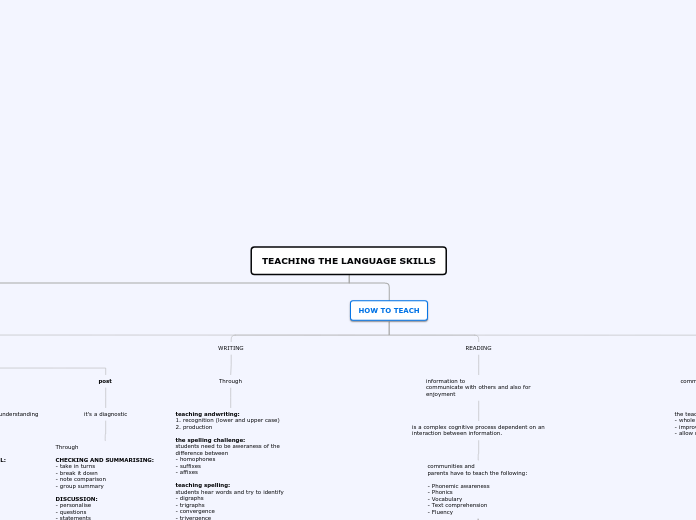TEACHING THE LANGUAGE SKILLS
Topic principal
HOW TO TEACH
LISTENING
pre
prepare what the students are gonna hear
Through
BRAINSTORMING:
- from one to many
- poster display
- brainwalking
- board writing
- shout to the scribe
VISUAL:
- pictures
- guest what's happening
- picture story
- studentss as artists
- guide visualitation
REALIA:
- photos
- brochures
- othe objects
TEXTS AND WORDS:
- court case
- fill exercise
- key words
- L1 first
SITUATIONS:
- functions
- mystery headlines
- problem - solving
OPINIONS:
- KWL charts
- speed writing
- group writing
- quatations
- backgrounding
- quizzes
- advance organisers
while
evidence of understanding - non understanding
Through
LISTENING FOR DETAIL:
- bingo
- times
- spot the difference
- a story told twice
- mixed focus
- hoarse whisperers
INFERRING:
- pause and predicct
- not her/him
- twuelve questions
PARTICIPATING ACTIVELY:
- listen and describe
- interrupted storytelling
- truth or lie
- infotmation transfer
DICTATION:
- interactive dictation
- dictigloss
- picture dictation
- gap dictaation
- false facts dictation
- grading dictation
- running dictation
- transcribe
LISTEN AND DO:
- simon says
- last one is out
- stand up if...
- change chairs if
- blind man's bluff
- grab the word
- mime
- just do it
post
it's a diagnostic
Through
CHECKING AND SUMMARISING:
- take in turns
- break it down
- note comparison
- group summary
DISCUSSION:
- personalise
- questions
- statements
- sorting list
- pros and cos
CREATIVE RSPONSES:
- genre transfer
- moral and headline
- wirte on
- hot seat
INFORMATION EXCHANGE:
- genre transfer
- moral and headline
- wirte on
- hot seat
PROBLEM SOLVING:
- listing
- sorting
- ranking
WRITING
Through
teaching andwriting:
1. recognition (lower and upper case)
2. production
the spelling challenge:
students need to be aweraness of the
difference between
- homophones
- suffixes
- affixes
teaching spelling:
students hear words and try to identify
- digraphs
- trigraphs
- convergence
- trivergence
using activities like
- backward spelling
- secret codes
- crosses and noughts
teaching puntuation and copying:
checking puntuation using many texts
and trying to use puntuation correctly
READING
information to
communicate with others and also for
enjoyment
is a complex cognitive process dependent on an
interaction between information.
communities and
parents have to teach the following:
- Phonemic awareness
- Phonics
- Vocabulary
- Text comprehension
- Fluency
before
using:
- Brainstorm llinked to
the story in some way
- Introduce essential vocabulary using
visuals, sketches and realia
- Discussion
- Focused questions to check
understanding of key concepts
- Prediction activities using key
vocabulary, visuals, realia
- Sequencing pictures
- Sequencing a series of key words
while
using:
- Complete a cloze activity
- Categorizing texts
- Skeleton texts
- Retelling the story
-Working out the meaning of unfamiliar
words
after
using:
-Offering personal opinions about
the text
- Completing the sentences
-Choosing characters from a
set of visuals
- Telling the story from another
perspective
- Retell/comprehend the story
in another language form
SPEAKING
communicative activities
the teacher's role providing:
- whole task practice
- improve motivation
- allow natural learning
functional communicative activities
1. describing pictures
2. discovering identical pairs
3. discovering sequences
4. discovering missing information
social interaction activities
1. discussions
2. role plays
the situation must to stimulated
the students' creation and points of view
Effective listening:
use attentive body language
Look the speaker in the eye
Expressions like mhm
Ask questions
Note the meaning of silences
using
planned input
activities like:
- photos
- firsts
- childhood anecdotes
- chat show
- biographies
semi planned input
spontaneous input
